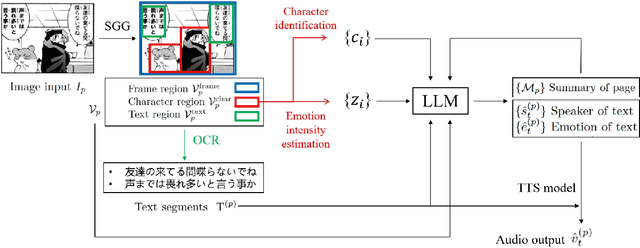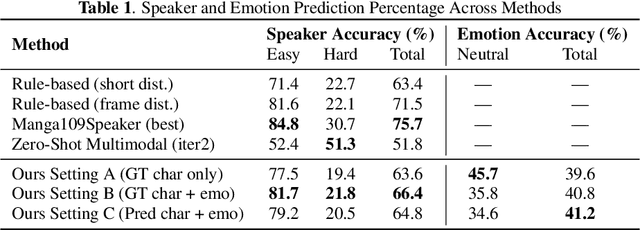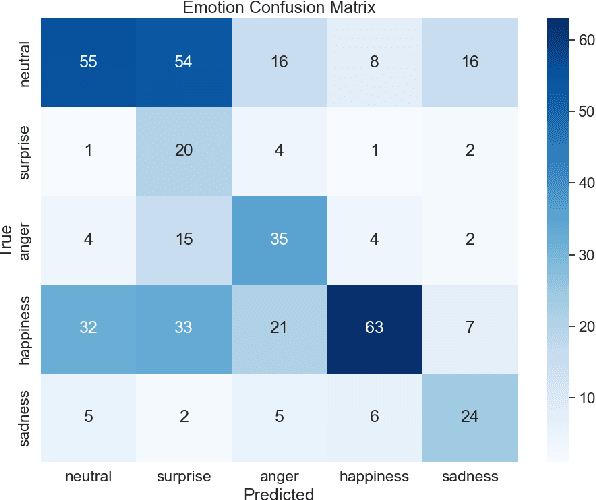speech
Papers and Code
Towards Human-like Multimodal Conversational Agent by Generating Engaging Speech
Sep 18, 2025Human conversation involves language, speech, and visual cues, with each medium providing complementary information. For instance, speech conveys a vibe or tone not fully captured by text alone. While multimodal LLMs focus on generating text responses from diverse inputs, less attention has been paid to generating natural and engaging speech. We propose a human-like agent that generates speech responses based on conversation mood and responsive style information. To achieve this, we build a novel MultiSensory Conversation dataset focused on speech to enable agents to generate natural speech. We then propose a multimodal LLM-based model for generating text responses and voice descriptions, which are used to generate speech covering paralinguistic information. Experimental results demonstrate the effectiveness of utilizing both visual and audio modalities in conversation to generate engaging speech. The source code is available in https://github.com/kimtaesu24/MSenC
Llama-Mimi: Speech Language Models with Interleaved Semantic and Acoustic Tokens
Sep 18, 2025



We propose Llama-Mimi, a speech language model that uses a unified tokenizer and a single Transformer decoder to jointly model sequences of interleaved semantic and acoustic tokens. Comprehensive evaluation shows that Llama-Mimi achieves state-of-the-art performance in acoustic consistency and possesses the ability to preserve speaker identity. Our analysis further demonstrates that increasing the number of quantizers improves acoustic fidelity but degrades linguistic performance, highlighting the inherent challenge of maintaining long-term coherence. We additionally introduce an LLM-as-a-Judge-based evaluation to assess the spoken content quality of generated outputs. Our models, code, and speech samples are publicly available.
Impact of Phonetics on Speaker Identity in Adversarial Voice Attack
Sep 18, 2025Adversarial perturbations in speech pose a serious threat to automatic speech recognition (ASR) and speaker verification by introducing subtle waveform modifications that remain imperceptible to humans but can significantly alter system outputs. While targeted attacks on end-to-end ASR models have been widely studied, the phonetic basis of these perturbations and their effect on speaker identity remain underexplored. In this work, we analyze adversarial audio at the phonetic level and show that perturbations exploit systematic confusions such as vowel centralization and consonant substitutions. These distortions not only mislead transcription but also degrade phonetic cues critical for speaker verification, leading to identity drift. Using DeepSpeech as our ASR target, we generate targeted adversarial examples and evaluate their impact on speaker embeddings across genuine and impostor samples. Results across 16 phonetically diverse target phrases demonstrate that adversarial audio induces both transcription errors and identity drift, highlighting the need for phonetic-aware defenses to ensure the robustness of ASR and speaker recognition systems.
Mitigating Intra-Speaker Variability in Diarization with Style-Controllable Speech Augmentation
Sep 18, 2025Speaker diarization systems often struggle with high intrinsic intra-speaker variability, such as shifts in emotion, health, or content. This can cause segments from the same speaker to be misclassified as different individuals, for example, when one raises their voice or speaks faster during conversation. To address this, we propose a style-controllable speech generation model that augments speech across diverse styles while preserving the target speaker's identity. The proposed system starts with diarized segments from a conventional diarizer. For each diarized segment, it generates augmented speech samples enriched with phonetic and stylistic diversity. And then, speaker embeddings from both the original and generated audio are blended to enhance the system's robustness in grouping segments with high intrinsic intra-speaker variability. We validate our approach on a simulated emotional speech dataset and the truncated AMI dataset, demonstrating significant improvements, with error rate reductions of 49% and 35% on each dataset, respectively.
UMA-Split: unimodal aggregation for both English and Mandarin non-autoregressive speech recognition
Sep 18, 2025This paper proposes a unimodal aggregation (UMA) based nonautoregressive model for both English and Mandarin speech recognition. The original UMA explicitly segments and aggregates acoustic frames (with unimodal weights that first monotonically increase and then decrease) of the same text token to learn better representations than regular connectionist temporal classification (CTC). However, it only works well in Mandarin. It struggles with other languages, such as English, for which a single syllable may be tokenized into multiple fine-grained tokens, or a token spans fewer than 3 acoustic frames and fails to form unimodal weights. To address this problem, we propose allowing each UMA-aggregated frame map to multiple tokens, via a simple split module that generates two tokens from each aggregated frame before computing the CTC loss.
Listening, Imagining \& Refining: A Heuristic Optimized ASR Correction Framework with LLMs
Sep 18, 2025Automatic Speech Recognition (ASR) systems remain prone to errors that affect downstream applications. In this paper, we propose LIR-ASR, a heuristic optimized iterative correction framework using LLMs, inspired by human auditory perception. LIR-ASR applies a "Listening-Imagining-Refining" strategy, generating phonetic variants and refining them in context. A heuristic optimization with finite state machine (FSM) is introduced to prevent the correction process from being trapped in local optima and rule-based constraints help maintain semantic fidelity. Experiments on both English and Chinese ASR outputs show that LIR-ASR achieves average reductions in CER/WER of up to 1.5 percentage points compared to baselines, demonstrating substantial accuracy gains in transcription.
HARNESS: Lightweight Distilled Arabic Speech Foundation Models
Sep 18, 2025Large pre-trained speech models excel in downstream tasks but their deployment is impractical for resource-limited environments. In this paper, we introduce HArnESS, the first Arabic-centric self-supervised speech model family, designed to capture Arabic speech nuances. Using iterative self-distillation, we train large bilingual HArnESS (HL) SSL models and then distill knowledge into compressed student models (HS, HST), preserving Arabic-specific representations. We use low-rank approximation to further compact the teacher's discrete supervision into shallow, thin models. We evaluate HArnESS on Arabic ASR, Speaker Emotion Recognition (SER), and Dialect Identification (DID), demonstrating effectiveness against HuBERT and XLS-R. With minimal fine-tuning, HArnESS achieves SOTA or comparable performance, making it a lightweight yet powerful alternative for real-world use. We release our distilled models and findings to support responsible research and deployment in low-resource settings.
From Who Said What to Who They Are: Modular Training-free Identity-Aware LLM Refinement of Speaker Diarization
Sep 18, 2025Speaker diarization (SD) struggles in real-world scenarios due to dynamic environments and unknown speaker counts. SD is rarely used alone and is often paired with automatic speech recognition (ASR), but non-modular methods that jointly train on domain-specific data have limited flexibility. Moreover, many applications require true speaker identities rather than SD's pseudo labels. We propose a training-free modular pipeline combining off-the-shelf SD, ASR, and a large language model (LLM) to determine who spoke, what was said, and who they are. Using structured LLM prompting on reconciled SD and ASR outputs, our method leverages semantic continuity in conversational context to refine low-confidence speaker labels and assigns role identities while correcting split speakers. On a real-world patient-clinician dataset, our approach achieves a 29.7% relative error reduction over baseline reconciled SD and ASR. It enhances diarization performance without additional training and delivers a complete pipeline for SD, ASR, and speaker identity detection in practical applications.
Frustratingly Easy Data Augmentation for Low-Resource ASR
Sep 18, 2025This paper introduces three self-contained data augmentation methods for low-resource Automatic Speech Recognition (ASR). Our techniques first generate novel text--using gloss-based replacement, random replacement, or an LLM-based approach--and then apply Text-to-Speech (TTS) to produce synthetic audio. We apply these methods, which leverage only the original annotated data, to four languages with extremely limited resources (Vatlongos, Nashta, Shinekhen Buryat, and Kakabe). Fine-tuning a pretrained Wav2Vec2-XLSR-53 model on a combination of the original audio and generated synthetic data yields significant performance gains, including a 14.3% absolute WER reduction for Nashta. The methods prove effective across all four low-resource languages and also show utility for high-resource languages like English, demonstrating their broad applicability.
Emotion-Aware Speech Generation with Character-Specific Voices for Comics
Sep 18, 2025



This paper presents an end-to-end pipeline for generating character-specific, emotion-aware speech from comics. The proposed system takes full comic volumes as input and produces speech aligned with each character's dialogue and emotional state. An image processing module performs character detection, text recognition, and emotion intensity recognition. A large language model performs dialogue attribution and emotion analysis by integrating visual information with the evolving plot context. Speech is synthesized through a text-to-speech model with distinct voice profiles tailored to each character and emotion. This work enables automated voiceover generation for comics, offering a step toward interactive and immersive comic reading experience.
 Add to Chrome
Add to Chrome Add to Firefox
Add to Firefox Add to Edge
Add to Edge